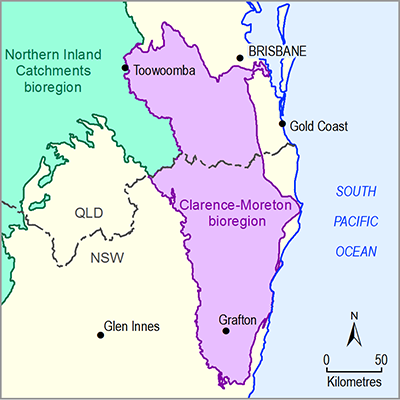This section summarises the conceptual geological and hydrogeological understanding of deep and shallow rock units in the Clarence-Moreton bioregion and how they interact with each other, building on knowledge reported in companion products 1.1, 1.2, 1.5 and 2.1-2.2 (Rassam et al., 2014; Raiber et al., 2014; McJannet et al., 2015; and Raiber et al., 2016, respectively). It describes the connectivity between deep and shallow aquifer systems as well as their interaction with the surface water system, thus highlighting the possible pathways through which water-dependent assets may ultimately be impacted by potential coal seam gas (CSG) developments in the bioregion. Section 2.3.5 discusses specific causal pathways in the context of CSG operations.
Open-cut coal mine operations have occurred in both the Queensland and NSW parts of the Clarence-Moreton bioregion. However, coal mines in north-eastern NSW were generally small operations and have closed decades ago. As of early 2016, there is only one operational coal mine (Jeebropilly Mine) in the Clarence-Moreton bioregion in Queensland. The analysis of the CRDP for the Clarence-Moreton bioregion (Section 2.3.4) suggests that based on current information no new coal mines are expected in this area in the foreseeable future. CSG development is likely to be restricted to the Richmond river basin of north-eastern NSW (Figure 6 and Figure 7) (Section 2.3.4; companion product 1.2 for the Clarence-Moreton bioregion (Raiber et al., 2014)). Hence, the groundwater model developed to predict potential impacts of CSG activities on water-dependent assets (described in companion product 2.6.2 of the Clarence-Moreton bioregion (Cui et al., 2016b)) only focuses on the Richmond river basin in the Clarence-Moreton bioregion.
This section therefore focuses on the geological, hydrogeological and hydrological characteristics of the Richmond river basin to support the development of the groundwater model. However, many of the conceptual models presented for different geological units in the Richmond river basin are applicable across other parts of the Clarence-Moreton bioregion such as the adjoining Logan-Albert river basin, the Lockyer Valley and the Brisbane river basin (Figure 6) due to geological similarity. Such similarities across different parts of the Clarence-Moreton bioregion in NSW and Queensland mean that conceptual models developed by the Queensland Department of Environment and Heritage Protection for south-east Queensland, available on their Interactive WetlandInfo website (Department of Environment and Heritage Protection, 2013), can be adopted for this bioregional assessment (BA). Combining those pictorial conceptual models with the two-dimensional and three-dimensional representations of the Richmond river basin underpin the current conceptual understanding of how different components of the hydrological cycle interact.
Figure 6 Richmond river basin and spatial relationship to Richmond River groundwater model domain
A three-dimensional geological model was developed for the entire Clarence-Moreton bioregion.
Data: Bioregional Assessment Programme (Dataset 1)


